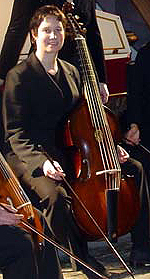Viola da gamba Bass
Jakob Stainer Absam, 1671
Catalog 104. Viola da gamba, bass, Jakob Stainer – Absam, 1671
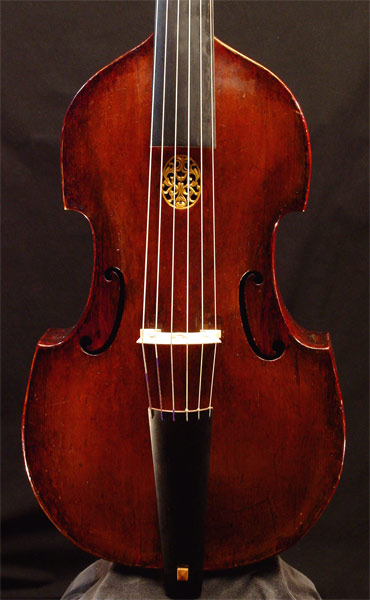 |
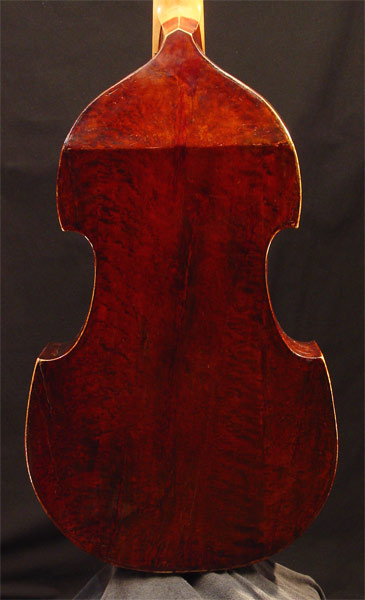 |
During the 17th and 18th C. Jakob Stainer was ubiquitously acknowledged to be the greatest luthier of all times. A violin by Stainer would command a price of 7 to 8 times that of a Stradivari; the fashion for that Cremonese master came towards the end of the 18th and the beginning of the 19th C. Heinrich Biber ordered instruments from Stainer for the Salzburg Court; Johann Sebastian Bach played on a Stainer Viola; Francesco Maria Veracini, a violin virtuoso, affectionately named his two Stainer violins “Petrus & Paulus”; Leopold Mozart played throughout his life on one of his excellent instruments and decried the decline of quality of contemporary (1750) violin making. Stainer’s instruments have been copied more frequently that any other maker in history.
All the bass viols by Jakob Stainer were made on exactly the same pattern: their contours can be superimposed on one another. He invariably used bird’s eye maple for the back and sides although some were made of several stripes of different species of woods. The moulding of the arching is also typical for the master and suffers little variance. Unusual for this instrument is however the presence of a rosette, rare on a Stainer viol, and the use of the c- holes instead of the more typical f-holes. It is however documented that Stainer copied the English viols brought from London to Innsbruck by the viol virtuoso, William Young, a Catholic, who was forced to flee his native country and was given a position at the Tirolese court. Therefore it would be safe to assume that this viol is precisely one of these copies, English instruments having almost always C-holes and very frequently a decorative rosette. Apparently Stainer was willing enough to place a rosette and change the shape of the sound holes, but he would not acquiesce to changing the style of his arching or even the details in the execution of the sound holes, as the comparison of the tongues of the holes on a violin , this viola da gamba and another one in the collection clearly show. A perfunctory examination of the c-holes on other viols in the colleciton would serve to point out this significant stylistic difference.
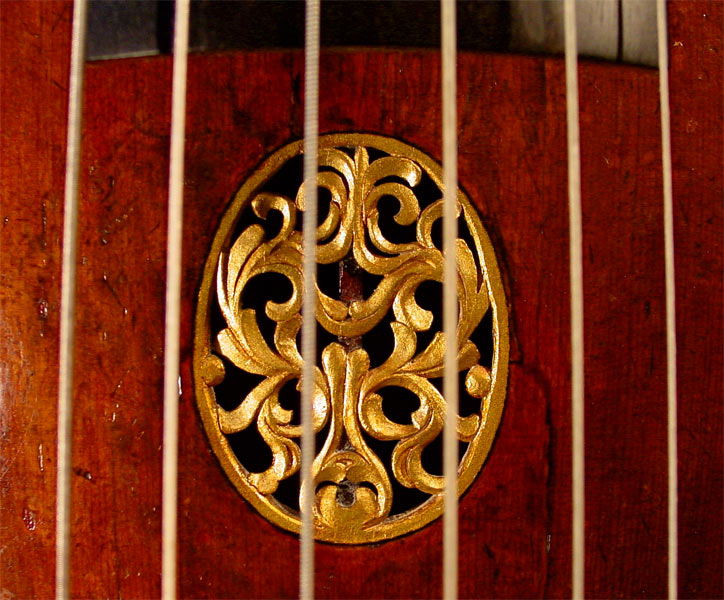
A prestigeous imperial court the likes of the Habsburg Dynasty, with its proverbially lavish musical establishment, may have well occasionally imported the best from abroad, but it also fostered indigenous instrument-making to such a degree, that its craftsmen were able to earn universal acclaim, both at home and beyond the imperial confines, throughout the 17th and 18th. Centuries. Jakob Stainer († 1684), from Absam in Tyrol, ubiquitously acknowledged to be the greatest luthier of all times, set the standard for European violin-making until 1800; his violin would command a price six or seven times greater than those of Antonio Stradivari. It is only towards the very end of the 18th Century that the fashion for that Cremonese master superceded that of Stainer and his followers. Heinrich Biber ordered instruments from Stainer for the Salzburg Court; Johann Sebastian Bach played on a Stainer Viola; Francesco Maria Veracini, a violin virtuoso, affectionately named his two Stainer violins “Petrus & Paulus”; Pietro Antonio Locatelli performed his bold concerti on a Stainer violin; Leopold Mozart played throughout his life on one of his excellent instruments and decried the decline of quality of contemporary (1750) violin making. Stainer’s instruments have been copied more frequently that any other maker in history.
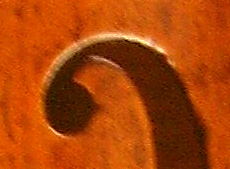 |
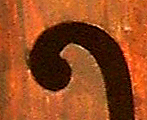 |
 |
Left: detail of a soundhole from a Stainer violin
Middle: the upper part of the hole of this bass viol
Right: soundhole on the anonymous bass viol viol in the collection
(Analysis courtesey of Roland Hoüel)
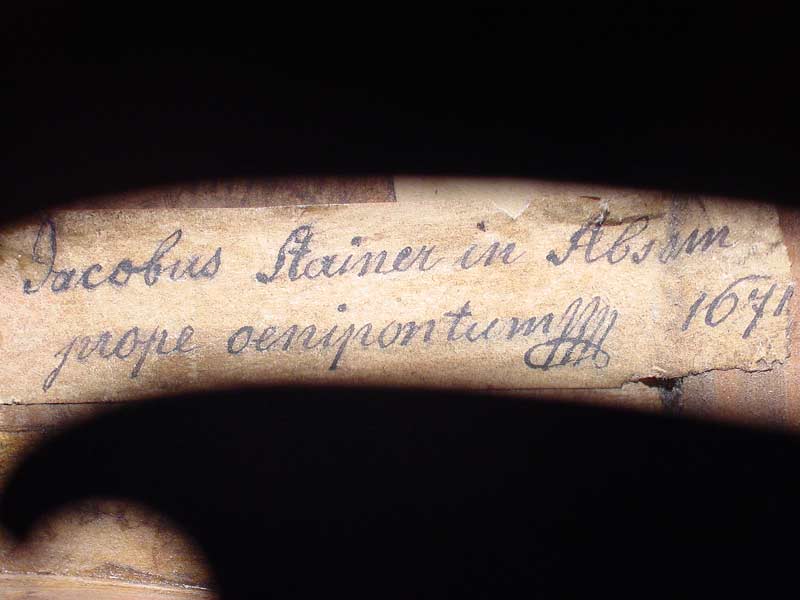
This viola da gamba shows all the characteristics of the Tyrolean master: the high, harmonious arching, the excellent choice of woods (note the use of bird’s eye maple for the back and sides, present in all of his viols), the consummate modelling of the outline, nearly identical for all his viols. Unusual in this instrument are the presence of a rosette and of C-holes (instead of the more common f-holes). It is known, however, that the Englishman William Young, who received an appointment in Innsbruck (as a Catholic, he was forced to leave his homeland), had his viols copied by Stainer: since English viols had very often rosettes and always C-holes, our viol may very well be one of those copies. Dendrochronological studies of the University of Hamburg yielded annular rings from 1504 to 1633, verifying the date of the instrument..
Der Violist da gamba William Young kam aus England 1652 an den Innsbrucker Hof Erzherzog Ferdinand Karls, wo er über ein Jahrzehnt, als Virtuose und Kammerdiener vom Fürsten überaus geschätzt, tätig war. Anlässlich einer Bestellung einer Viola da gamba für den Pfarrchor in Meran schreibt Stainer: ” ich habe den form und manier von des Engelenders Violen, welcher beim Erzherzog Ferdinando, seeligster gedechtnus, in diensten und under den berumdtisten Viola d gambisten gewest, welches Viola zu London in Engelandt gemacht worden und gar hoch in gelt gewest”.
| Body length | 687 mm |
|
Upper width
|
315 mm |
| Middle width | 235 mm |
| Lower width | 413 mm |
| Rib height | 137 mm |
| String length | 707 mm |
![]()
Sonate en Ré majeur pour deux violes de gambe – Allegro
Dendrochronological analysis
(Dendrochronology is the science of dating objects made out of wood by measuring the year rings in the wood used in the object’s construction and comparing the results to data banks collected for this purpose. This methods establishes with reasonable certainty a date before which the instrument could not have been made. Most violin makers use woods which have been aged for about five to ten years.)
|
Bericht über die dendrochronologische Untersuchung einer Bei der zweiteiligen Decke wurden auf der Diskantseite 125 Jahrringe und auf der Bassseite 123 Jahrringe gemessen und mit einer Fichtenchronologie für den Bereich Alpen datiert. Dabei konnte die Diskantseite zwischen 1504 und 1628 und die Basseite zwischen 1511 und 1633 eingeordnet werden. Somit stammt der jüngste auf der Decke gemessene Jahrring aus dem Jahre 1633. Bei einer minimalen Lagerzeit des Holzes von einem Jahr kann die Decke frühestens ab 1634 entstanden sein. Beide Seite der Decke stammen von demselben Baum. i.A. Micha Beuting Prof. Dr. Peter Klein |
Report on the dendrochronological analysis of a On the two-part front were measured 125 year-rings on the treble side and 123 year-rings on the bass side and were dated with a spruce chronology for the Alpine region. Thus the treble side could be dated between 1504 and 1628 and the bass side between 1511 and 1633. Therefore the youngest year-ring present on the front comes from the year 1633. Considering a minimal time for curing the wood of one year, the front could have been made in 1634 at the earliest. Both sides of the top came from the same tree. Micha Beuting, on behalf of Prof. Dr. Peter Klein |
Eva Fürtinger has been a member of the Orpheon Consort for many years and has used many of the instruments of the collection for international competitions, concerts and recordings. Among her favourites is most certainly the Tielke bass viol, but for this concert in Holland she selected the magnificent Jakob Stainer of 1671.
See also: Audiovisual presentations
Do you wish to hear this instrument? Marais and his World!
Marin Marais
François Couperin; La Sultanne
François Couperin: Sultanne 2
